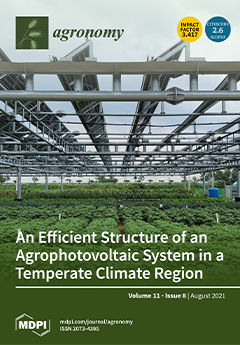The application of nitrification inhibitors (NIs) is considered to be an efficient way to delay nitrification, but the effect of NIs combinations on soil nitrification and ammonia (NH
3) volatilization are not clear in soils with different pH values. In this study,
[...] Read more.
The application of nitrification inhibitors (NIs) is considered to be an efficient way to delay nitrification, but the effect of NIs combinations on soil nitrification and ammonia (NH
3) volatilization are not clear in soils with different pH values. In this study, we explored the effect of nitrapyrin (CP) and its combinations with 3, 4-dimethylepyrazole phosphate (DMPP), dicyandiamide (DCD) on the transformation of nitrogen, potential nitrification rate (PNR), and ammonia (NH
3) volatilization in a 120-day incubation experiment with three different pH values of black soil. Treatments included no fertilizer (Control), ammonium sulfate (AS), AS+CP (CP), AS+CP+DMPP (CP+DMPP), and AS+CP+DCD (CP+DCD). The application of NIs significantly decreased NO
3−-N contents and potential nitrification rate (
p < 0.05), while significantly increased NH
4+-N contents (
p < 0.05), especially CP+DCD and CP+DMPP were the most effective in the neutral and alkaline soils, respectively. In the acid soil, CP significantly increased total NH
3 volatilization by 31%, while CP+DCD significantly reduced by 28% compared with AS. However, no significant difference was found in NH
3 volatilization with and without NIs treatments (
p > 0.05) in the neutral and alkaline soils. In conclusion, the combined nitrification inhibitors had the better efficiency in all three tested soils. CP+DCD and CP+DMPP are the most effective in inhibiting soil nitrification in the clay soils with higher pH value and lower organic matter, while CP+DCD had the potential in mitigating environment pollution by reducing N loss of NH
3 volatilization in the loam soil with lower pH value and higher organic matter. It provided a theoretical basis for the application of high efficiency fertilizer in different soils. Further studies under field conditions are required to assess the effects of these nitrification inhibitors.
Full article





